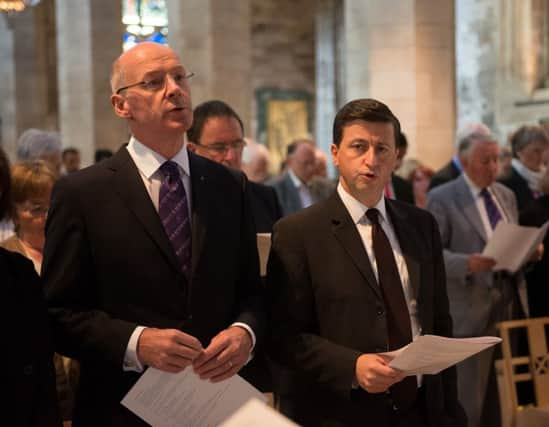Leaders: Delivering devolution pledges is crucial


The service, marked by symbols of reconciliation and unity at St Giles Cathedral, was attended by more than a thousand people. Among them were senior political figures from both the Yes and Better Together camps, including shadow foreign secretary Douglas Alexander, Alistair Darling, and the SNP’s John Swinney.
It was an event sorely necessary after a two-and-a-half-year campaign that, while it was on the whole peaceful, was marred by intimidation, angry words, and aggressive behaviour. These negative aspects now have to be put behind us.
Advertisement
Hide AdAdvertisement
Hide AdThat, of course, will be no easy task given the confusion and doubts that have already arisen over the pledge signed by David Cameron, Labour leader Ed Miliband and Liberal Democrat leader Nick Clegg last Tuesday to deliver more powers for the Scottish parliament. A motion to be laid before the UK Parliament today sets out a tight timetable.
But already there are divisions that cast serious doubt, not only on how quickly this pledge can be honoured but whether the party leaders can secure the support of their backbenchers for such legislation. The Prime Minister has insisted that the timetable would be followed, while Alistair Darling said it was “non-negotiable.”
However, there is marked disagreement over how the process of devolution legislation should be handled. Mr Cameron wants changes to move in parallel with plans to make sure only English MPs can vote on English laws – a major constitutional change for the UK. Mr Miliband, fearing that this could neuter the power of any future Labour administration, wants a slower process with further debate.
What is certain is that, whatever ambitious timetable will be proposed, any legislation will be subject to intense debate and scrutiny to ensure not only that it is robust but that it also marshals support across the UK as a whole and regions that feel neglected. That, after all, is what parliaments are for.
The Westminster leaders will need time to reach agreement. It will not be at all easy. But the major problem they face is that failure to deliver would unleash fresh bitterness and recrimination across Scotland: wounds not healed, but opened even further amid bitter cries of betrayal.
Fortunes favour the brave
Confused by currencies? Befuddled by bitcoins? Then a new bullion trading website launched by the Royal Mint may be the perfect bolt-hole for you. It allows consumers to buy bullion coins struck in gold or silver directly from the mint as well as being able to sell coins back.
It could spark a gold rush by broadening the appeal of the bullion coin market and making it easier for people to buy from a trusted source. And if storage is a problem for your bulk purchase, the Royal Mint offers an on-site facility – protected round the clock by the MoD. The new service certainly captures the imagination, even if it might not capture the loose change at the back of the sofa. Even for experienced investors, gold can be a volatile asset whose price is driven by powerful emotions of fear and greed.
The economist John Maynard Keynes denounced it as a “barbarous relic”. But it has survived as the ultimate “safe haven asset”, held by central banks the world over, acceptable in transactions round the globe, a fabulous metal for decoration and jewellery fabrication and, (for some of the time) a superb hedge against inflation.
Advertisement
Hide AdAdvertisement
Hide AdFor most of the 1990s, the price of gold drifted lower before soaring to more than $1,800 (£1,100) an ounce four years ago. It has since drifted down to $1,222 as inflation – so far – has remained subdued despite massive money printing by governments.
Gold trading is for the brave. Yes, the price can explode on geo-political tensions, wars and inflation. But it should be considered a long-term asset – and it could be a long term indeed before you see your money back. Neither the Mint nor the MoD can run to such a guarantee.